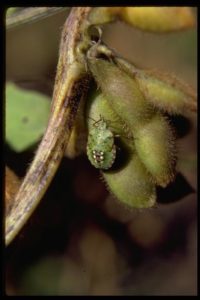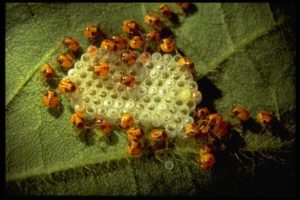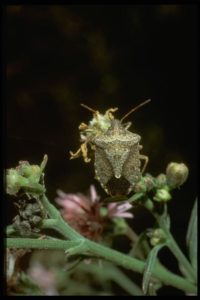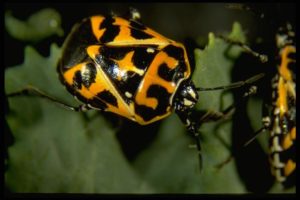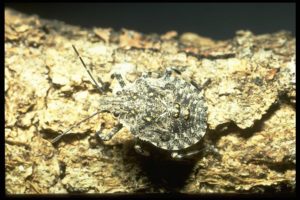Common Name: Southern green stink bug
Scientific Name: Nezara viridula (Linnaeus)
Order: Hemiptera
Description: Adults are about 1/2 to 3/4-inch in length and are solid green. Immature stages vary in color from black for very small nymphs to green for larger nymphs. However, the immature stages have a distinctive pattern of whitish spots on the abdominal segments. Nymphal stages are often found together in high numbers because eggs are laid in clusters that appear as rows of small barrels on and around suitable food sources. Development from egg to adult requires about 35 days, but varies with temperature. Up to five generations per year may occur with greater numbers appearing in the fall before adults overwinter.
There are a number of different species of stink bugs common in Texas, including: the conchuela stink bug, Chlorochroa ligata (Say); the brown stink bug, Euschistus servus (Say); the harlequin bug, Murgantia histrionica (Hahn); the rice stink bug, Oebalus pugnax (Fabricius); and the spined shouldered stink bug, Podisus maculiventris (Say). Most are plant feeding although a few, such as the spined shouldered stink bug are predaceous on other insects. One stink bug species, Brochymena arborea (Say), closely resembles the color and texture of tree bark on which it lives.
Life Cycle: Simple metamorphosis; adults deposit barrel-shaped eggs; immature stages develop through five stages or instars that appear similar to adults except that they do not have fully developed wings. Several generations can be produced each year.
Habitat, Food Source(s), Damage: The southern green stink bug feeds on a wide variety of developing fruit, including cotton, peaches and tomatoes, and seeds such as pecan, sorghum and soybeans. They also feed on the parts of many ornamental and wild plants.
In fruit, such as tomatoes, damage is of two types. When the young green fruit is injured, the cells at the site of feeding are killed by the toxic saliva injected by the bugs into the plant. This area of the fruit stops expanding, while the cells around the dead cells continue to expand by increasing their water content. The result is deformed fruit that appears to have dimples. This type of damage has been called “cat facing.” When ripened or nearly ripened fruit is injured, the injection of toxic saliva merely kills a cluster of cells that later forms an off-color hard mass in the fruit, reducing fruit quality and producing a bad flavor to the fruit. Some plant diseases are spread by stink bug feeding.
Pest Status: Plant feeder; has well developed scent glands and will emit a distinctive disagreeable odor when handled; medically harmless.
For additional information, contact your local Texas A&M AgriLife Extension Service agent or search for other state Extension offices.
Literature: Drake 1920; Slater and Baranowski 1978.
- Southern green stink bug, Nezara viridula (Linnaeus) (Hemiptera: Pentatomidae), adult on tomato. Photo by Drees.
- Southern green stink bug, Nezara viridula (Linnaeus) (Hemiptera:Pentatomidae), nymph on soybean. Photo by Drees.
- Southern green stink bug, Nezara viridula (Linnaeus) (Hemiptera:Pentatomidae), nymphs hatching from eggs. Photo by Drees.
- Brown stink bug, Euschistus servus (Say) (Hemiptera: Pentatomidae). Photo by Jackman.
- Harlequin bug, Murgantia histrionica (Hahn) (Hemiptera: Pentatomidae). Photo by Drees.
- A “rough” stink bug or “tree” stink bug, Brochymena sp. (Hemiptera: Pentatomidae), nymph. Photo by Drees.

